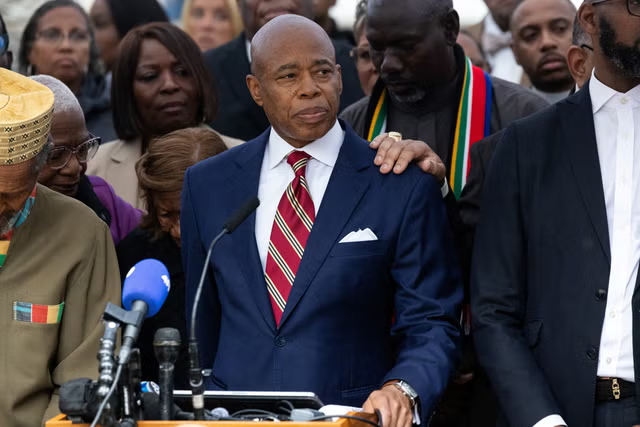BRUSSELS (AP) — Little brings more heavenly bliss to the faithful or otherworldly wonder to casual visitors than ethereal hymns cascading amid the columns of Catholic cathedrals. That is, unless the composer is a known molester or someone accused of sexual abuse.
A few days before the highlight of Pope Francis’ visit to Belgium — a Mass at the biggest stadium in Brussels — the specially selected choir of 120 was rehearsing a brand-new closing hymn when it became known that the composer was a priest accused of molesting young women.
The hymn was hastily removed from the order of service and replaced with another composition but it was too late to reprint the official Magnificat booklet for the Mass because of the number of copies required. The name of the alleged abuser, who died two weeks ago, is right there at the bottom of page 52, next to a request for donations, with a bank account number and a QR code.
It was the latest controversy in the Belgian church’s decades-long struggle to come to terms with an appalling history of sex abuse and cover-ups by its priests and clergy — a legacy Francis will confront in person when he meets with survivors of the abuse during his visit.
“I pointed it out to them,” said the Rev. Rik Deville, a retired priest who has been a torchbearer for survivors of church abuse for three decades. “What happened with the hymn is only a symptom of a much wider problem. They still cannot deal with the issue,” he said in an interview with The Associated Press.
For over two decades, Belgium has been facing a continual cascade of abuse reports that officially total several hundred known cases but which, advocates say, are only the tip of the iceberg: Many of the victims and perpetrators have died, or the alleged crimes have exceeded their statute of limitations.
Deville said victims in villages come face to face with such issues on a weekly basis. The Sunday Mass scandal only started to roll early this week when an abuse victim pointed out to a local bishop that he had warmly eulogized the recently deceased priest-composer who had, in fact, been an abuser.
As a result, the Bishop of Limburg, Patrick Hoogmartens, announced he wouldn’t take part in celebratory papal events. It set off the chain of events leading to the change in the Mass program.
“It is only now because it is an international event that something is done about it,” said Deville. “But such things happen on a weekly basis in parishes across the nation that victims are confronted like that. And then nothing is done about it.”
Church authorities said the hymns were chosen in coordination with the musicians who were unaware of the case, which only came to public attention after the recent death of the priest. Hundreds of churches across Belgium still have hymnbooks with his works.
Archbishop Luc Terlinden promised the church would look into it as soon as the Pope leaves.
“Every Sunday in every parish his songs are sung. So it is a wider problem. And I want to look into this as of Monday to see what we will do in the future with our policy on culprits, on facts out of respect for the victims,” Terlinden told VRT network.
Debates over what to do with art, be it music or paintings, when the artist has engaged in problematic or even criminal behavior, have confronted the church and society at large for centuries, long before “cancel culture” became a buzzword.
Few people argue that Caravaggio’s religious masterpieces should be destroyed or taken down because of his criminal life: The man he killed is dead, as is he.
But in Los Angeles four years ago, the archdiocese banned the music of Catholic composer David Haas amid an investigation into allegations of sexual misconduct, allegations Haas strenuously denied.
And more recently, the mosaics of one of the Catholic Church’s most acclaimed contemporary artists, the Rev. Marko Rupnik, have come under scrutiny.
Rupnik’s Jesuit religious order expelled him in 2023 after more than two dozen women accused him of spiritual, psychological and sexual abuses, some while he was creating the artwork. Francis reopened a church investigation amid suspicions that Rupnik had escaped punishment in Francis’ Jesuit-friendly Vatican.
Rupnik hasn’t responded publicly to the allegations, but his art studio has defended him and denounced what it has called a media “lynching.”
The issue about what to do with his artwork is not minor, since Rupnik’s mosaics decorate the facades and altars of some of the most-visited basilicas and churches around the world, including at Lourdes, France; in Fatima, Portugal and even in the Vatican’s apostolic palace.
So far, the bishop of Lourdes decided to keep the Rupnik mosaics — for now — because there was no consensus within a committee of experts he formed about what to do with them. The Knights of Columbus religious fraternity decided this summer to cover the mosaics at its shrine in Washington, and chapel in Connecticut.
But earlier this year, the head of the Vatican’s communications department created an uproar when he defended the continued use of images of Rupnik’s mosaics on the Vatican’s own news portal, Vatican News, even as a canonical investigation is underway at the Vatican’s sex crimes office.
He argued, as have others, that one must separate the art from the artist.
That argument did not sit well with the pope’s top adviser on child protection and fighting clergy abuse, Cardinal Sean O’Malley. He penned a letter to the heads of all Vatican offices in June urging them to refrain from displaying Rupnik’s artwork as a gesture to abuse victims.
“Pastoral prudence would prevent displaying artwork in a way that could imply either exoneration or a subtle defense,” he wrote in June. “We must avoid sending a message that the Holy See is oblivious to the psychological distress that so many are suffering.”
___
Associated Press religion coverage receives support through the AP’s collaboration with The Conversation US, with funding from Lilly Endowment Inc. The AP is solely responsible for this content.
Disclaimer: The copyright of this article belongs to the original author. Reposting this article is solely for the purpose of information dissemination and does not constitute any investment advice. If there is any infringement, please contact us immediately. We will make corrections or deletions as necessary. Thank you.



